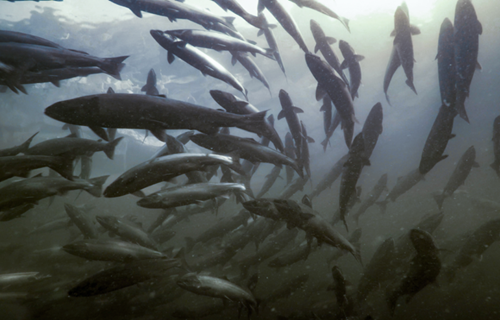
Credit: Richard -Davies
To coincide with the release of the fourth episode of Wild Isles, a new BBC One wildlife series presented by Sir David Attenborough, in which he states that “there has been a 70% loss in 25 years and [wild Atlantic] salmon could be extinct in the next two decades”, Missing Salmon Alliance members are coming together to highlight the crisis faced by this king of fish. The plight of our wild Atlantic salmon is symbolic of the wider biodiversity crisis facing our freshwater and marine environments. In both, it could be said, they are the “canary in the coalmine” for a vast array of species and habitats under threat.
As part of the series, Sir David Attenborough documents the life-cycle of a species that undergoes one of the planet’s most challenging and fascinating migrations - our wild Atlantic salmon. On April 2nd, Sir David will take us on the salmon’s journey from source to sea, following the course of our freshwater as it travels through our UK landscapes.
Atlantic salmon begin their lives in freshwater, and after 1-3 years, the young fish travel to sea to feed and grow before returning to their natal spawning grounds 1-3 years later to lay the eggs that will make up the next generation.
However, they face many pressures along the way. As young salmon head downstream towards the sea, they encounter river pollution, parasites, and predation. If they survive these initial threats, the salmon’s instincts drive them on, towards a giant oceanic current stretching from the Bay of Biscay in the south, to the Vøring Plateau off the west coast of Norway – to reach their summer feeding grounds in the North Atlantic. Once there they mature and grow, feeding on the abundance of food. Some fish then return to their native rivers after one year at sea (known as grilse), while others will spend another year or more at sea, travelling further afield, continuing as far as the west coast of Greenland. All the while, they must avoid predation, netting, overfishing, the impact of salmon farms, pollution, and a warming climate.
Returning to their natal rivers they struggle against a number of issues which people have created, poor water quality, low water quantity, warming water, and manmade barriers such as dams– all of which are serious threats to their survival.
Mark Bilsby, CEO of Missing Salmon Alliance member, Atlantic Salmon Trust, member, said “This remarkable species faces a host of problems wherever they go. They need our help to safeguard their future. They inform us of much wider issues and we need to listen to them before it’s too late. We cannot imagine a world without wild Atlantic salmon in our rivers and that is why we need to do all that we can to take action now.”
Dylan Roberts, Head of the Salmon and Trout Research centre for Missing Salmon Alliance member, the Game and Wildlife Conservation Trust, said “People may see plenty of salmon, at the supermarket fish counter or on restaurant menus, but this is all farmed salmon and thus don’t understand that our wild Atlantic salmon are in such a perilous state. Numbers of wild salmon in our rivers are now below sustainable population levels and are really on the brink”
The wild Atlantic salmon is in crisis; salmon have been around for 6,000,000 years and now, they face extinction within our lifetime.
As a migratory species that traverses many regions and habitats in both freshwater and marine worlds, salmon are a key indicator species to the health of those environments.
Determined to safeguard the future of our wild Atlantic salmon, the members of the Missing Salmon Alliance, a coalition of the UK’s leading conservation organisations focused on saving our salmon, are working together to take better care of this iconic species; calling for cold, clean water so they can not only survive, but thrive in our rivers and at sea.
The Missing Salmon Alliance (MSA) continues to advocate for the protection of freshwater environments and the improvement of water quality and quantity across the UK in order to reduce losses of salmon in our rivers, coastal waters, and the open ocean.